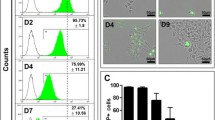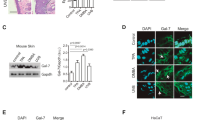Abstract
Indoleamine 2,3-dioxygenase (IDO) is generally considered to be immunosuppressive but recent findings suggest this characterization oversimplifies its role in disease pathogenesis. Recently, we showed that IDO is essential for tumor outgrowth in the classical two-stage model of inflammatory skin carcinogenesis. Here, we report that IDO loss did not exacerbate classical inflammatory responses. Rather, IDO induction could be elicited by environmental signals and tumor promoters as an integral component of the inflammatory tissue microenvironment even in the absence of cancer. IDO loss had limited impact on tumor outgrowth in carcinogenesis models that lacked an explicit inflammatory tumor promoter. In the context of inflammatory carcinogenesis where IDO was critical to tumor development, the most important source of IDO was radiation-resistant non-hematopoietic cells, consistent with evidence that loss of the IDO regulatory tumor suppressor gene Bin1 in transformed skin cells facilitates IDO-mediated immune escape by a cell autonomous mechanism. Taken together, our results identify IDO as an integral component of ‘cancer-associated’ inflammation that tilts the immune system toward tumor support. More generally, they promote the concept that mediators of immune escape and cancer-associated inflammation may be genetically synonymous.





Similar content being viewed by others
References
Balkwill F, Mantovani A (2001) Inflammation and cancer: back to Virchow? Lancet 357(9255):539–545
Peek RM, Mohla S, DuBois RN (2005) Inflammation in the genesis and perpetuation of cancer: summary and recommendations from a National Cancer Institute-sponsored meeting. Cancer Res 65:8583–8586
Coussens LM, Werb Z (2002) Inflammation and cancer. Nature 420(6917):860–867
Balkwill F, Charles KA, Mantovani A (2005) Smoldering and polarized inflammation in the initiation and promotion of malignant disease. Cancer Cell 7(3):211–217
Dunn GP, Old LJ, Schreiber RD (2004) The immunobiology of cancer immunosurveillance and immunoediting. Immunity 21(2):137–148
Gajewski TF (2007) Failure at the effector phase: immune barriers at the level of the melanoma tumor microenvironment. Clin Cancer Res 13(18 Pt 1):5256–5261
Munn DH, Mellor AL (2006) The tumor-draining lymph node as an immune-privileged site. Immunol Rev 213:146–158
Koebel CM, Vermi W, Swann JB, Zerafa N, Rodig SJ, Old LJ et al (2007) Adaptive immunity maintains occult cancer in an equilibrium state. Nature 450(7171):903–907
Sotomayor EM, Borrello I, Rattis FM, Cuenca AG, Abrams J, Staveley-O’Carroll K et al (2001) Cross-presentation of tumor antigens by bone marrow-derived antigen-presenting cells is the dominant mechanism in the induction of T-cell tolerance during B-cell lymphoma progression. Blood 98(4):1070–1077
Yu P, Rowley DA, Fu YX, Schreiber H (2006) The role of stroma in immune recognition and destruction of well-established solid tumors. Curr Opin Immunol 18(2):226–231
Zhang B, Bowerman NA, Salama JK, Schmidt H, Spiotto MT, Schietinger A et al (2007) Induced sensitization of tumor stroma leads to eradication of established cancer by T cells. J Exp Med 204(1):49–55
Ball HJ, Sanchez-Perez A, Weiser S, Austin CJ, Astelbauer F, Miu J et al (2007) Characterization of an indoleamine 2,3-dioxygenase-like protein found in humans and mice. Gene 396(1):203–213
Metz R, DuHadaway JB, Kamasani U, Laury-Kleintop L, Muller AJ, Prendergast GC (2007) Novel tryptophan catabolic enzyme IDO2 is the preferred biochemical target of the antitumor IDO inhibitory compound D-1MT. Cancer Res 67:7082–7087
Munn DH, Mellor AL (2007) Indoleamine 2,3-dioxygenase and tumor-induced tolerance. J Clin Invest 117(5):1147–1154
Mellor AL, Sivakumar J, Chandler PKS, Molina H, Mao D et al (2001) Prevention of T cell-driven complement activation and inflammation by tryptophan catabolism during pregnancy. Nat Immunol 2:64–68
Munn DH, Zhou M, Attwood JT, Bondarev I, Conway SJ, Marshall B et al (1998) Prevention of allogeneic fetal rejection by tryptophan catabolism. Science 281:1191–1193
Muller AJ, DuHadaway JB, Sutanto-Ward E, Donover PS, Prendergast GC (2005) Inhibition of indoleamine 2,3-dioxygenase, an immunomodulatory target of the tumor suppressor gene Bin1, potentiates cancer chemotherapy. Nat Med 11:312–319
Muller AJ, Prendergast GC (2007) Indoleamine 2,3-dioxygenase in immune suppression and cancer. Curr Cancer Drug Targets 7(1):31–40
Muller AJ, Sharma MD, Chandler PR, Duhadaway JB, Everhart ME, Johnson BA III et al (2008) Chronic inflammation that facilitates tumor progression creates local immune suppression by inducing indoleamine 2,3 dioxygenase. Proc Natl Acad Sci USA 105(44):17073–17078
Chang M, Boulden J, Katz JB, Wang L, Meyer TJ, Soler AP et al (2007) Bin1 ablation increases susceptibility to cancer during aging, particularly lung cancer. Cancer Res 67:7605–7612
Hardy RR, Carmack CE, Shinton SA, Kemp JD, Hayakawa K (1991) Resolution and characterization of pro-B and pre-B cell stages in normal mouse bone marrow. J Exp Med 173:1213–1225
Chang M, Boulden J, Sutanto-Ward E, Duhadaway JB, Soler AP, Muller AJ et al (2007) Bin1 ablation in mammary gland delays tissue remodeling and drives cancer progression. Cancer Res 67:100–107
Hou DY, Muller AJ, Sharma MD, DuHadaway J, Banerjee T, Johnson M et al (2007) Inhibition of indoleamine 2,3-dioxygenase in dendritic cells by stereoisomers of 1-methyl-tryptophan correlates with antitumor responses. Cancer Res 67(2):792–801
Muller AJ, DuHadaway JB, Jaller D, Curtis P, Metz R, Prendergast GC (2010) Immunotherapeutic suppression of IDO and tumor growth by ethyl pyruvate. Cancer Res 70(5):1845–1853
Brunkow ME, Jeffery EW, Hjerrild KA, Paeper B, Clark LB, Yasayko SA et al (2001) Disruption of a new forkhead/winged-helix protein, scurfin, results in the fatal lymphoproliferative disorder of the scurfy mouse. Nat Genet 27(1):68–73
Fontenot JD, Gavin MA, Rudensky AY (2003) Foxp3 programs the development and function of CD4+CD25+ regulatory T cells. Nat Immunol 4(4):330–336
Waterhouse P, Penninger JM, Timms E, Wakeham A, Shahinian A, Lee KP et al (1995) Lymphoproliferative disorders with early lethality in mice deficient in Ctla-4. Science 270(5238):985–988
Tivol EA, Borriello F, Schweitzer AN, Lynch WP, Bluestone JA, Sharpe AH (1995) Loss of CTLA-4 leads to massive lymphoproliferation and fatal multiorgan tissue destruction, revealing a critical negative regulatory role of CTLA-4. Immunity 3(5):541–547
Mellor AL, Baban B, Chandler P, Marshall B, Jhaver K, Hansen A et al (2003) Cutting edge: induced indoleamine 2,3 dioxygenase expression in dendritic cell subsets suppresses T cell clonal expansion. J Immunol 171(4):1652–1655
Robinson CM, Shirey KA, Carlin JM (2003) Synergistic transcriptional activation of indoleamine dioxygenase by IFN-gamma and tumor necrosis factor-alpha. J Interferon Cytokine Res 23(8):413–421
Prendergast GC, Jaffee EM (2007) Cancer immunologists and cancer biologists: why we didn’t talk then but need to now. Cancer Res 67(8):3500–3504
Brandacher G, Perathoner A, Ladurner R, Schneeberger S, Obrist P, Winkler C et al (2006) Prognostic value of indoleamine 2,3-dioxygenase expression in colorectal cancer: effect on tumor-infiltrating T cells. Clin Cancer Res 12(4):1144–1151
Chamuleau ME, van de Loosdrecht AA, Hess CJ, Janssen JJ, Zevenbergen A, Delwel R et al (2008) High INDO (indoleamine 2,3-dioxygenase) mRNA level in blasts of acute myeloid leukemic patients predicts poor clinical outcome. Haematologica 93(12):1894–1898
Ino K, Yoshida N, Kajiyama H, Shibata K, Yamamoto E, Kidokoro K et al (2006) Indoleamine 2,3-dioxygenase is a novel prognostic indicator for endometrial cancer. Br J Cancer 95(11):1555–1561
Okamoto A, Nikaido T, Ochiai K, Takakura S, Saito M, Aoki Y et al (2005) Indoleamine 2,3-dioxygenase serves as a marker of poor prognosis in gene expression profiles of serous ovarian cancer cells. Clin Cancer Res 11(16):6030–6039
Pan K, Wang H, Chen MS, Zhang HK, Weng DS, Zhou J et al (2008) Expression and prognosis role of indoleamine 2,3-dioxygenase in hepatocellular carcinoma. J Cancer Res Clin Oncol 134(11):1247–1253
Urakawa H, Nishida Y, Nakashima H, Shimoyama Y, Nakamura S, Ishiguro N (2009). Prognostic value of indoleamine 2,3-dioxygenase expression in high grade osteosarcoma. Clin Exp Metastasis 26(8):1005–1012
Weinlich G, Murr C, Richardsen L, Winkler C, Fuchs D (2007) Decreased serum tryptophan concentration predicts poor prognosis in malignant melanoma patients. Dermatology 214(1):8–14
Yoshikawa T, Hara T, Tsurumi H, Goto N, Hoshi M, Kitagawa J et al (2009) Serum concentration of L-kynurenine predicts the clinical outcome of patients with diffuse large B-cell lymphoma treated with R-CHOP. Eur J Haematol 84(4):304–309
Arefayene M, Philips S, Cao D, Mamidipalli S, Desta Z, Flockhart D et al (2009) Identification of genetic variants in the human indoleamine 2,3-dioxygenase (IDO1) gene, which have altered enzyme activity. Pharmactogenet Genomics 19:464–476
Witkiewicz AK, Costantino CL, Metz R, Muller AJ, Prendergast GC, Yeo CJ et al (2009) Genotyping and expression analysis of IDO2 in human pancreatic cancer: a novel, active target. J Am Coll Surg 208(5):781–787 (discussion 7–9)
Muller AJ, Scherle PA (2006) Targeting the mechanisms of tumoral immune tolerance with small-molecule inhibitors. Nat Rev Cancer 6(8):613–625
Griner EM, Kazanietz MG (2007) Protein kinase C and other diacylglycerol effectors in cancer. Nat Rev Cancer 7(4):281–294
Sayama S, Yoshida R, Oku T, Imanishi J, Kishida T, Hayaishi O (1981) Inhibition of interferon-mediated induction of indoleamine 2,3-dioxygenase in mouse lung by inhibitors of prostaglandin biosynthesis. Proc Natl Acad Sci USA 78(12):7327–7330
Basu GD, Tinder TL, Bradley JM, Tu T, Hattrup CL, Pockaj BA et al (2006) Cyclooxygenase-2 inhibitor enhances the efficacy of a breast cancer vaccine: role of IDO. J Immunol 177(4):2391–2402
Lee SY, Choi HK, Lee KJ, Jung JY, Hur GY, Jung KH et al (2009) The immune tolerance of cancer is mediated by IDO that is inhibited by COX-2 inhibitors through regulatory T cells. J Immunother 32(1):22–28
Munn DH, Sharma MD, Hou D, Baban B, Lee JR, Antonia SJ et al (2004) Expression of indoleamine 2,3-dioxygenase by plasmacytoid dendritic cells in tumor-draining lymph nodes. J Clin Invest 114(2):280–290
Acknowledgments
This work was supported by grants from the DoD Breast Cancer Research Program (A.J.M., G.C.P.), Pennsylvania Department of Health CURE/Tobacco Settlement Award (A.J.M.) and NIH grants CA82222 (G.C.P.), CA109542 (G.C.P.), and CA070739 (S.K.G.). Additional support was also provided by New Link Genetics Corporation, Dan Green Foundation, Lankenau Hospital Foundation, and the Main Line Health System (G.C.P.). A conflict of interest is declared by G.C.P., A.J.M., and J.B.D. who have intellectual property rights and financial interests in New Link Genetics Corporation which is developing IDO inhibitors for treatment of cancer and other diseases.
Author information
Authors and Affiliations
Corresponding author
Electronic supplementary material
Below is the link to the electronic supplementary material.
Rights and permissions
About this article
Cite this article
Muller, A.J., DuHadaway, J.B., Chang, M.Y. et al. Non-hematopoietic expression of IDO is integrally required for inflammatory tumor promotion. Cancer Immunol Immunother 59, 1655–1663 (2010). https://doi.org/10.1007/s00262-010-0891-4
Received:
Accepted:
Published:
Issue Date:
DOI: https://doi.org/10.1007/s00262-010-0891-4




